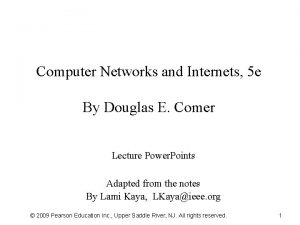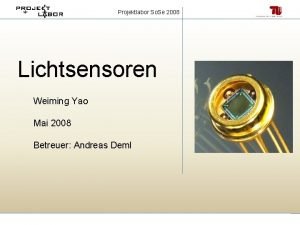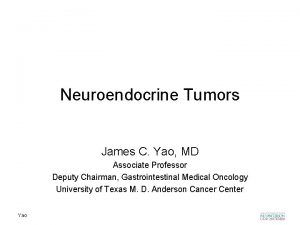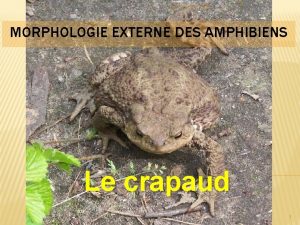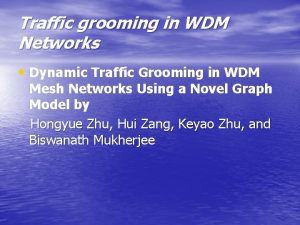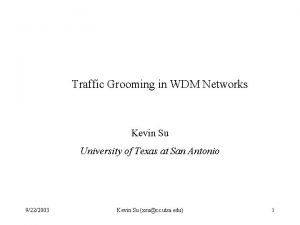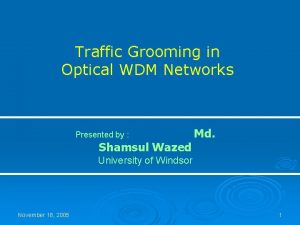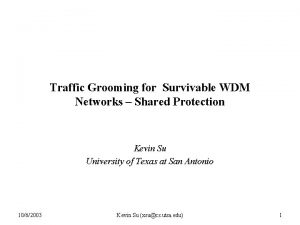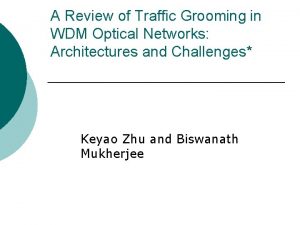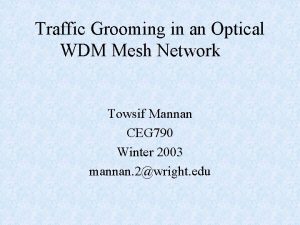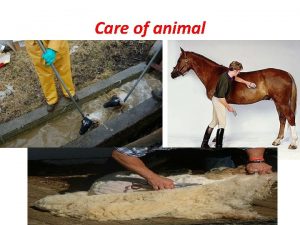Traffic Grooming in WDM Networks Wang Yao WDM

























- Slides: 25

Traffic Grooming in WDM Networks Wang Yao

WDM Technology l increases the transmission capacity of optical fibers l allows simultaneously transmission of multiple wavelengths within a single fiber

SONET ring network is currently the most widely deployed optical network infrastructure l SONET Add/Drop Multiplexer (SADM) can be used to aggregate lower rate stream from different end-users into a single highrate SONET stream in Time Division Multiplexing (TDM) fashion. l In SADM, traffic needs to be processed in electronic domain. l

SONET over WDM l With WDM technology, multiple SONET rings can be supported on a single fiber pair by using multiple wavelengths. l Requires more electronic multiplexing equipments. l The cost of electronics, instead of the cost of optics, dominates the cost of optical network

Optical Bypass using WADM WDM add/drop multiplexers (WADMs) provide the ability to drop (or add) only the wavelength that carries the traffic destined to (or originated from) the node. l On the other hand, WADMs bypass other wavelengths optically. l

Traffic Grooming l Every wavelength needs a SADM only at every node where it is ended l Using the optical bypassing capacity provided by WADMs, the traffic can be groomed in such a way that the total number of SADMs needed is minimized.

Traffic Grooming Illustrated (I) l Unidirectional ring network with four nodes l each wavelength supports an OC-48 ring l between each pair of nodes there are eight OC-3 circuits

Traffic Grooming Illustrated (II) Traffic assignment: l 1: 1↔ 2, 3↔ 4 l 2: 1↔ 3, 2↔ 4 l 3: 1↔ 4, 2↔ 3

Traffic Grooming Illustrated (III) Traffic assignment: l 1: 1↔ 2, 1↔ 3 l 2: 2↔ 3, 2↔ 4 l 3: 1↔ 4, 3↔ 4

Traffic Grooming & RWA (I) l without considering sharing of SADMs, each lightpath requires two SADMs l Proper routing and wavelength assignment (RWA) allows more sharing of SADMs among lightpaths

Traffic Grooming & RWA (II) l RWA#1 1: 1↔ 2, 2↔ 3, 4↔ 5, 5↔ 6, 7↔ 8, 8↔ 9 (9 SADMs) 2: 1↔ 3, 4↔ 6, 7↔ 9 (6 SADMs) Total = 15 SADMs l RWA#2 1: 1↔ 2, 2↔ 3, 3↔ 1 (3 SADMs) 2: 4↔ 5, 5↔ 6, 6↔ 4 (3 SADMs) 2: 7↔ 8, 8↔ 9, 9↔ 7 (3 SADMs) Total = 9 SADMs

Traffic Grooming & RWA (III) l Two-step approach to design network – low level grooming of tributaries traffic onto lightpaths – executing RWA algorithm on the resulting lightpaths l An improvement of 20% can be achieved if the two steps are considered jointly.

Traffic Grooming & RWA (IV) l Two goals to design network – Minimum number of wavelengths – Minimum number of electronic equipments (SADMs) l The two goals may not be achieved simutaneously

Modeling Traffic Grooming l Integer Linear Programming (ILP) approach Single-hop bidirectional ring

Modeling Traffic Grooming l Nomenclature

Modeling Traffic Grooming l Computational Complexity – NP-complete – Needs heuristic algorithm l Special Cases – Static traffic – Uniform traffic – Hub traffic

Grooming Benefit unidirectional ring with uniform traffic

A Heuristic Two-Step Approach l Pack traffic demands (e. g. , OC-3 s) into circles – Capacity of each circle equals to basic tributary rate (OC-3) – Contains nonoverlapping traffic l All the circles are grouped into wavelengths – As many end nodes as possible must be matched

Grooming Dynamic Traffic l Most earlier works focus on static traffic, which is applicable in network design with well-estimated steady traffic demands l Traffic demands may change over a long period, it is important to accommodate traffic changes.

Grooming with Cross-Connects Another approach to reduce SADMs is to use cross-connects at several nodes. l Cross-connects is capable of switch traffic from one wavelength to another wavelength l Various network architectures with different amounts of cross-connect capabilities have been studied. l Usually less electronics can be achieved at the expense of more wavelengths. l

Grooming in IP/WDM Networks l In future IP over WDM networks, SADMs may not be needed. l The function of multiplexing traffic onto wavelengths falls on IP routers. l Optical bypass ability may be provided by WDM cross-connect.

Grooming in IP/WDM Networks Without optical bypass, routers would be burdened with processing information on all wavelengths. l The goal is to minimized the number of ports in networks. l

Grooming in Mesh Networks l Due to the increase of Internet traffic, more WDM networks would be deployed in general mesh topology to meet this demands. Thus more work needs to be done in the mesh networks grooming problem.

Acknowledgement l This presentation document is based on the following papers. 1. 2. 3. Eytan Modiano and Phil Lin, "Traffic Grooming in WDM networks, " IEEE Communications Magazine, July, 2001. J. Wang, W. Cho, V. R. Vemuri, and B. Mukherjee, “Improved Approaches for Cost-Effective Traffic Grooming in WDM Ring Networks: ILP Formulations, Single-Hop and Multihop Connections, ” IEEE/OSA Journal of Lightwave Technology, vol. 19, no. 11, pp. 1645 -1653, Nov. 2001. X. Zhang and C. Qiao, “An Effective and Comprehensive Approach to Traffic Grooming and Wavelength Assignment in SONET/WDM Rings, ” IEEE/ACM Transactions on Networking, VOL. 8, No. 5, October 2000.

Thanks!
 Fdm tdm wdm in computer networks
Fdm tdm wdm in computer networks Inbound traffic vs outbound traffic
Inbound traffic vs outbound traffic All traffic solutions traffic cloud
All traffic solutions traffic cloud Traffic management in computer networks
Traffic management in computer networks Difference between virtual circuit and datagram
Difference between virtual circuit and datagram Backbone networks in computer networks
Backbone networks in computer networks Model yuan yao
Model yuan yao Yao tong xue
Yao tong xue Yufeng yao
Yufeng yao Yaojiaxin
Yaojiaxin Dep cpu
Dep cpu Bangpeng yao
Bangpeng yao Ye qiu
Ye qiu Yao jiaxin
Yao jiaxin Weiming yao
Weiming yao Michelle yao md
Michelle yao md Yao yanze
Yao yanze Yuan yao math
Yuan yao math Tao yao
Tao yao Dr yao md anderson
Dr yao md anderson Hongyi yao
Hongyi yao Chief machemba of yao
Chief machemba of yao Dr patrick yao
Dr patrick yao Bin yao
Bin yao Dynamic network surgery for efficient dnns
Dynamic network surgery for efficient dnns Wu bi shan yao wan
Wu bi shan yao wan
